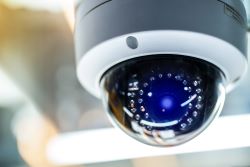How Long Should It Take To Mount A Camera In My Waiting Room
Risk Considerations for Using Surveillance Cameras in Healthcare Practices
Marcy A. Metzgar

Some providers are installing surveillance cameras in their healthcare practices. They may choose to do so because they want to protect and secure the equipment, records, and medications in their offices; their employees; and their patients. Some wish to prevent access into their practices by unauthorized individuals that may result in theft, violence, or patient record violations. Others want to preclude whatsoever concrete or exact abuse that may occur. And some appreciate beingness able to monitor their practices remotely.
These providers should carefully consider the purpose for installing surveillance cameras to balance their security concerns with their obligation to safeguard their patients' protected health data (PHI) and comply with HIPAA privacy and security requirements.
No specific federal dominion addresses surveillance cameras in medical or dental offices. However, information technology'due south imperative that providers are aware of their state laws and regulations that apply to recording. For example, some states allow sound recording if at to the lowest degree ane party to the conversation consents. In other states, all parties must consent to the recording. State laws as well might differ regarding telephone versus in-person recording requirements.1
Before installing surveillance systems, providers should devise a written policy that identifies their purpose for doing and then, the locations of the security cameras, employee notification method, signage posting, system security, privacy considerations, and archiving. The policy should include how the data volition be securely stored, how the footage showing an incident from the security cameras will exist maintained, besides equally specify who will manage the system, who will have access to the files, and under what circumstances.
Providers should determine the type of surveillance that is most appropriate and lawful in their country — live monitoring vs. recording — and include procedures in their written policy regarding the retention and release of recorded video. Depending on land law, providers may also need to exist prepared to respond to legal and patient requests to view surveillance tapes or supply a re-create of the recordings.
Since the laws and regulations differ from state to country, providers too may consider consulting their professional liability carrier, an attorney, or a compliance officer to talk over recording as well as HIPAA implications.
Hither are some steps to accept when installing surveillance cameras:2
- Install security cameras in visible (not concealed) common areas, such as the waiting room. You may also choose to put video surveillance in areas where important equipment is placed or where prescription medications are stored. Cameras should not be placed in test rooms, bathrooms, employee lunch or break rooms, or other areas where patients and employees accept a reasonable expectation of privacy.
- Ensure that the system is secured both physically (i.e., locked in a chiffonier) and digitally (i.e., password protected).
- Ensure that the cameras are positioned to avoid whatever view of patients' PHI, including information on charts or a computer screen.
- Inform all employees, in writing, that surveillance cameras are being used in the office. Your employees also should sign an acquittance form about the cameras, which should be filed in their human resources file.
- Mail service signage indicating that security cameras are in utilise. If five percent or more of your patients do not speak English, ensure that the signage appears in a 2nd language.
- Consider having your patients sign consent forms that indicate video security is in place. Include on this form how long you intend to shop video information that could include recordings of patients.
For information related to patients wishing to tape sound or video in healthcare practices, come across MedPro's Risk Q&A: Sound/Video Recording in Healthcare Practices.
Endnotes
Source: https://www.medpro.com/video-surveillance-healthcare-practices
Posted by: shawpuble1956.blogspot.com

0 Response to "How Long Should It Take To Mount A Camera In My Waiting Room"
Post a Comment